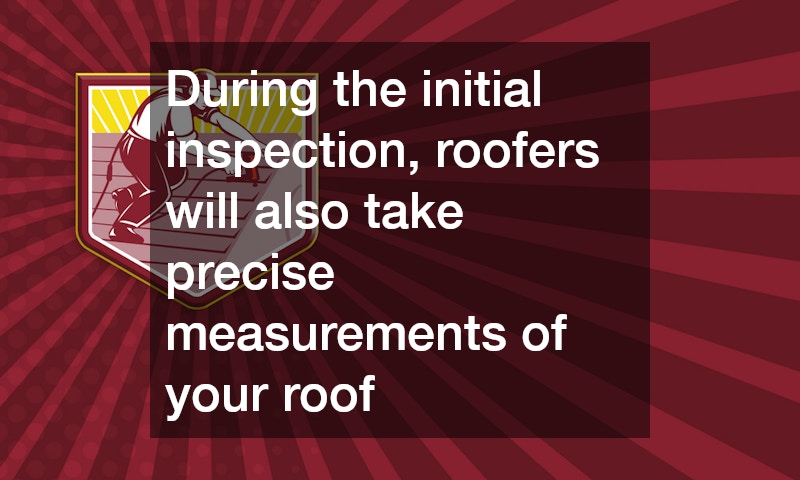
When embarking on a roof replacement, the journey begins with an important initial consultation and comprehensive inspection. During this phase, a roofing professional will visit your home to assess and evaluate the current condition of your roof. They will look for signs of damage such as water stains, mold growth, or missing shingles, which could compromise the integrity of your roof.
By identifying these issues early, the roofer can develop an appropriate plan for your roof replacement to ensure that existing problems are addressed before they worsen. This step is crucial as it sets the stage for a successful roof installation tailored to your home’s specific needs.
During the initial inspection, roofers will also take precise measurements of your roof. These measurements are vital for ordering the right amount of materials needed for the roof replacement. Accuracy in measurements ensures that there is neither a shortage nor an excess of roofing materials, thus optimizing the entire replacement process. Besides, understanding the dimensions and architectural complexities of the roof helps in planning the logistics of the replacement. It encompasses potential challenges such as accessibility, which can influence decisions about materials and additional labor requirements.
Furthermore, the consultation phase provides an opportunity to discuss your preferences and any specific concerns you may have. Whether you are interested in a particular roofing material or are seeking advice on energy-efficient options, this is the ideal time to communicate your goals. The roofing expert can offer recommendations tailored to your style and functional objectives, ensuring that you are fully informed about your choices before proceeding with the replacement. Additionally, this consultation serves as a platform to clarify any queries regarding budget, warranty, or timeline considerations, ensuring transparency and alignment between you and the roofing contractor.
Planning and Preparation
Once the inspection is complete and materials are selected, the next stage involves meticulous planning and preparation. This step is essential for setting up the roof replacement project for success. Roofing contractors will create a detailed project timeline that outlines each phase of the replacement, from the removal of the old roof to the installation and final cleanup. By developing a strategic plan, contractors ensure that there is minimal disruption to your daily routine while optimizing efficiency throughout the process. This includes scheduling work during favorable weather conditions to prevent any delays or complications.
In addition to creating a timeline, preparation involves ordering and organizing materials that will be used during the roof replacement. The correct quantity and type of roofing materials, as well as any necessary tools and safety equipment, need to be readily available before work begins. Contractors often coordinate with suppliers to ensure timely delivery of materials to avoid interruptions once the project is underway. Furthermore, the preparation applies to both materials and workforce management, as ensuring the availability of a skilled team plays a crucial role in the seamless execution of the roof replacement.
Another key aspect of preparation involves obtaining the necessary permits and adhering to local building codes. Roof replacements often require compliance with strict regulations to ensure safety and integrity. Roofing contractors typically handle the permit acquisition process, which saves you time and prevents any potential legal troubles. Additionally, during this preparation phase, the site area is prepped to ensure safety and accessibility. Protective measures are implemented to safeguard the surrounding landscape, property, and personal belongings from any potential damage caused during the roofing process.
Removal of Existing Roofing
The next phase in the roof replacement process is the removal of the existing roofing materials. This involves the careful dismantling of shingles, underlayment, and any other roofing components that need replacement. Removing the old roof is a critical step as it paves the way for setting up a solid foundation for the new roof. The process is labor-intensive and requires careful execution to ensure that only the necessary layers are removed without affecting the structural integrity of the home. Proper disposal methods are employed to responsibly discard and recycle roofing waste in accordance with environmental regulations.
During the removal stage, contractors may also identify hidden issues that were not apparent during the initial inspection. This could include detecting water damage, rot, or pest infestation that was previously unseen. While unexpected discoveries can alter the project scope, they are addressed promptly to avoid future complications. The thorough removal of underlying problems is essential for achieving long-lasting roofing solutions that effectively protect your property. By identifying and rectifying such issues early, contractors prevent future roof failures and extend the lifespan of the new installation.
Safety protocols are strictly adhered to during the removal process, with all workers equipped with necessary protective gear to prevent accidents or injuries. The site is kept organized, clean, and free from debris to facilitate both safety and efficiency. For the homeowner, this stage may present some noise and activity disruption, but it is typically short-lived. Many roofing companies communicate their progress with you throughout this stage, so you know what to expect and can plan accordingly. This ensures that you are kept informed every step of the way, making the roof replacement as smooth and stress-free as possible.
Installation of New Roofing
The installation of the new roofing materials is the heart of the roof replacement process. This phase begins with the installation of new underlayment, which acts as a critical moisture barrier beneath the shingles. Following the underlayment, the carefully selected shingles are installed, nailed down with precision to prevent any potential leaks or lifting in strong winds. Attention to detail during installation is crucial, as it ensures that the roof’s integrity is uncompromised and can withstand various weather conditions. The aesthetics of the roof are also a key consideration, ensuring the new roof enhances the property’s curb appeal.
In addition to shingles, flashing is installed around roof penetrations like chimneys, vents, and skylights for added protection against leaks. The integrity of flashing is vital, as it seals these vulnerable areas against moisture infiltration. Contractors follow manufacturer guidelines and established roofing practices to ensure each component of the roof system complements and supports others. Ventilation elements are also checked or replaced during this time to maintain proper airflow within the roof structure and the attic space. Adequate ventilation prevents heat and moisture buildup, contributing to the longevity of the roofing materials.
Once the installation is complete, a thorough inspection is conducted to ensure the new roof meets all stipulated quality standards. This final checkup involves inspecting every aspect of the job, from the alignment and fitment of materials to the functionality of drainage systems, ensuring the roof performs optimally. Any necessary adjustments are made, and the site is cleaned, leaving no debris, nails, or material remnants behind. The result is a completed roof replacement that embodies craftsmanship, durability, and beauty, providing homeowners with a secure and aesthetically pleasing addition to their homes. Finally, warranties and documentation are provided to the homeowner, outlining what to expect in terms of maintenance and lifespan.
Post-Installation Inspection and Cleanup
The final stage of your roof replacement encompasses a post-installation inspection and thorough cleanup of the job site. This ensures that the newly installed roof aligns with all agreed-upon specifications and standards. During the inspection, roofing experts examine the overall uniformity and adherence of the shingles and check for any overlooked areas as a precautionary measure. Problems rectified at this stage spare homeowners from future inconveniences and guarantee long-term satisfaction with the new roof’s performance. A comprehensive inspection is an essential part of delivering a high-quality roofing project.
Beyond the technical aspects of the inspection, contractors also ensure that the area around your home is returned to its original state. This involves removing all waste materials and debris generated during the roof replacement. Roof replacements, while necessary, should not leave a lasting negative impact on your landscape, driveway, or walkways. Professional roofers make sure that all waste is properly disposed of or recycled per local regulations, leaving your property cleaner than when they began. This level of diligence provides reassurance to homeowners that the project was managed with both quality and care, maintaining the aesthetic integrity of your home environment.
Finally, after the roof replacement is complete, you will receive important documentation and warranties pertaining to the materials and workmanship. Contractors typically discuss maintenance tips and any follow-up services to keep your new roof in optimal condition over the years. These discussions not only provide valuable insights but also foster a transparent relationship between you and your roofing contractor. Ensuring all your questions are answered gives you peace of mind and confidence in the durability and performance of your new roof. In the end, a successful roof replacement is marked by a reliable, beautiful roof that protects and enhances your home.

